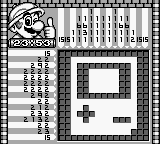Overview
 A 15x15 puzzle in Mario's Picross, where the final result resembles an actual Game Boy.
A 15x15 puzzle in Mario's Picross, where the final result resembles an actual Game Boy.Mario’s Picross (known in Japan as Mario no Picross) is a puzzle game developed by Jupiter (with Ape) and published by Nintendo for the Game Boy on March 1995 (in Japan and North America) and on July 1995 (in Europe).
One of the earliest games by Japanese studio Jupiter (along with UNO 2: Small World), Mario's Picross is a digital collection of logic puzzles known as nonograms (or "picture crossword puzzles", hence the name "Picross"), where players are given a square grid of tiles (5x5, 10x10, or 15x15) and must create a rudimentary picture by determining which tiles to darken (or "chisel away") based on the numerical clues of each row and column. Guiding them is the titular Nintendo mascot Mario, dressed as an archaeologist.
As the earliest digital adaptation of the nonogram puzzle, Mario's Picross includes a unique hint-based system for improving the game's pace. When attempting a puzzle, players are given 30 minutes to complete it (otherwise having to start over) and are deducted minutes immediately after filling in the wrong tile. Players can also deduct minutes for receiving a "hint" (automatically filling in a random row and column), and can optionally receive a free hint at the beginning of the puzzle. The game includes 256 puzzles, split into four categories: Easy Picross, Kinoko Course, Star Course, and Time Trials (the latter of which is unlockable, uses the traditional no-hint system, and uses time-based scoring).
International versions of the game are notable for having 10 unique puzzles, replacing puzzles that have cultural or drug/alcohol references. While the game received multiple sequels under the Picross name (including the console sequel Mario no Super Picross and the handheld sequel Picross 2), neither of them received a release outside of Japan until Picross DS 12 years later.
The game was later digitally re-released as a Virtual Console title for the Nintendo 3DS on July 14, 2011 (in Europe), August 4, 2011 (in North America), and August 22, 2011 (in Japan).
Gameplay
Picross puzzles involve a square grid of cells where the player must determine which cells should be colored in (or in the case of this game chiseled away) and which should be left blank. Numbers along the top and left side of the grid indicate the number and size of unbroken lines of filled in cells there are in the given row or column that are separated by at least one blank cell. For instance, if a row has the numbers “2 5 4”, that means that there are from left to right, a group of two colored in cells, a group of five colored in cells, and a group of four colored in cells, with all other cells being left blank and at least one blank cell between each group.
When a puzzle starts, the game gives the player the option of receiving a hint. If the player elects to be given a hint, one row and one column are randomly selected via roulette, and the solutions to those selected rows and columns are revealed. Each puzzle must be completed within a 30 minute time limit. Mistakes penalize the player by reducing the time left. The first mistake takes off two minutes, the second mistake takes off four minutes, and the penalty continues to double with each additional mistake. If the timer reaches 0:00 the player gets a Game Over and must start over. Players can mark cells that they know should not be filled in with an “X”. The game tracks the number of times each puzzle is attempted, the amount of time taken on the first completion of a puzzle, and the best completion time of a puzzle.
The game offers a total of 192 puzzles to solve divided into three groups of 64. The first group is labeled as “Easy Picross” and is intended to introduce the game and how it is played. In the initial puzzles of this group, Mario explains the basic rules, techniques, and logic of Picross in order slowly initiate newcomers to the puzzle type. The puzzles in “Easy Picross” consist of 8 puzzles of size 5x5, 40 10x10 puzzles, and 16 15x15 puzzles. Experienced players have the option of skipping over this set of puzzles straight into regular “Picross” mode which contains the other two groups, labeled as the “Kinoko Course” and “Star Course”. The “Kinoko Course” steps up the challenge from the initial “Easy Picross” group and contains only 15x15 sized puzzles. The “Star Course” is only available after completing the “Kinoko Course” and it contains the most challenging puzzles in the game, all of size 15x15.
Log in to comment